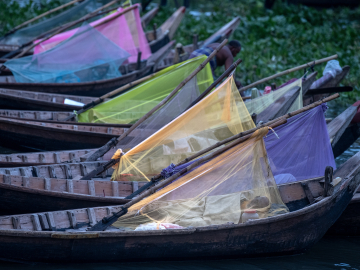A Flesh-eating Fungus Wrecks Lives and No One Cares
Wisal Altai’s disfigured foot is wedged into a flip flop with a golden strap. A crevice cuts across the foot’s surface at the base of five henna-stained toes that arch awkwardly upwards. Smaller scars from years of incisions meander out from the groove like river channels through a gorge.
Eight years ago, a donkey stepped on Altai’s bare foot. At first, the damage was minimal. The animal barely broke the skin. Yet a microscopic fungal spore, perhaps buried in the dirt floor of Altai’s house in the deserts of central Sudan, passed through the cut. Its filaments crept through her flesh. As the fungus cells multiplied, they formed small, hard grains that pushed aside muscles, tendons and bones. The initial wound healed within a few weeks, but a bump swelled in its place.
Over time, additional bulges formed, along with lesions that discharged encrusted seeds of fungus. When she could no longer walk well, Altai saw a doctor who carved out lumps of fungus and flesh. He gave Altai pills of an anti-fungal drug, called itraconozole, but she stopped taking the medicine after a series of possible side effects. Her breastfed baby became limp, she had trouble hearing, and she wasn’t getting pregnant. Those problems ceased once the drugs were out of her system, but her foot grew worse. Additional surgeries did little good. She now relies on a traditional healer who inflicts small burns around the growths to stop the menace from spreading. Over an indeterminate period of years, the condition may result in amputation and worse.
“I cannot walk distances,” she tells me, “and I cannot carry heavy things because it is painful.”
Robed in an embroidered black cloth, her eyes outlined in charcoal, Altai appears elegant despite the heat and her malady—a flesh-eating fungal infection called mycetoma. Doctors in at least 23 countries have reported the condition. Sometimes it is caused by fungi, and other times by bacteria, but invariably, the problem gets very little attention because it afflicts the poor. “This is a disease that causes high morbidity and deformity. It has a terrible impact on the lives of people, and on the economy of people,” says Anshu Banerjee, who was based in Sudan with the WHO from 2010 to 2014. “If you think about issues of equity, mycetoma really does need to be addressed,” Banerjee adds. “It makes poverty stay around.”
***
When the English physician Philip Manson described mycetoma in his seminal textbook from the 1950s, Manson’s Tropical Diseases, he wrote that patients’ limbs sprout “warty outgrowths resembling barnacles,” and those tumors, dissected, contain strands “resembling the excrement of earthworms.” Manson concludes, “After ten or twenty years, the patient dies, worn out by the continued drain.”
Unlike other diseases described in Manson’s book, a chapter on mycetoma wouldn’t be much different if written today. The state of the science is pretty much the same as it was back then, and so are the patients. Once called “Nomad’s Anguish,” mycetoma is a blight on migrants, herders, and farmers so poor they cannot afford shoes to protect their feet from thorns and other means of infection. In the past decade, researchers have identified 18 different species of fungus and 7 types of bacteria that cause the condition. The fungal variety is the more disabling of the two, and the more common in Sudan.
But beyond these small facts, little is known. There’s no decent treatment for the disease, no understanding of how the fungus grows within humans or where it lives when it’s not in people, and no one knows how many humans mycetoma afflicts. Most scientists have never heard of mycetoma, and those who have either don’t have the will to jump into a perpetually nascent field or the funds to conduct studies.
“Until someone in the United States or Europe gets mycetoma, no one will pay attention,” says Dr. Ahmed Fahal, a Sudanese surgeon who has spent the past 30 years trying to draw attention to the disease. You can’t blame him for feeling bitter. The decades have been packed with let-downs. The first time I met him, in May 2015, he looked crestfallen: He had flown to Geneva expecting the disease to be mentioned at the annual meeting of the World Health Assembly, only to find out on Monday morning that it would not be on the agenda after all. Still, he presses on in hope of a watershed moment that would prompt the rich world to glimpse at the patients he obsesses over every day.
***
Fahal has a manicured moustache and an unrelentingly distinguished air. In addition to directing the Mycetoma Research Center, he works at the University of Khartoum where he is a professor of surgery and the chief librarian overseeing the school’s vast collection of classic books. In a rare moment when he digressed from the topic of mycetoma, Fahal spoke fondly of his grandfather, Sudan’s first eye surgeon, who, he recalls, “was so dedicated to his patients.”
In the early 1980s, Fahal specialized in surgery at University College London. It was there that he met Alshiek Mahgoub, a Sudanese doctor who had written a book on mycetoma. Fahal was intrigued by the condition and asked Mahgoub if he could help him research the disease at a main hospital in Khartoum once he returned home. Mahgoub agreed.
Books did not prepare Fahal for the patients he found at Mahgoub’s one-room clinic set aside for mycetoma patients in Khartoum. They desperately needed help, but usually could not pay for the visit, never mind surgery or anti-fungal treatments. Even when they could afford medicine, the drugs were slow-acting, toxic, and largely unsuccessful once the disease had progressed. In those early days, Fahal found his calling, “I had a very clear vision,” he says, “My target was to stay in Sudan and help these patients.”
***
In 1989, a military coup overthrew the government, and the Islamic Front took power. Within the next few years, many doctors, professors, and other middle-class intellectuals were fired or left the country. But Fahal stayed put. His patients needed him. As the conflict in southern Sudan worsened, and then violence in Darfur escalated, the U.S. enforced comprehensive sanctions. They were intended to punish the militaristic ruling regime, but had—and continue to have—devastating effects on research and medicine. Nevertheless, Fahal raised money from friends, foundations, and the government’s Ministry of Health to build a laboratory and clinic devoted entirely to mycetoma in 1991.
The number of patients who visit the Mycetoma Research Center indicate that the disease is not uncommon. Since the clinic opened, Fahal says 7,210 people have been diagnosed there. In 2012 alone, the clinic diagnosed 402 new cases of the disease. And in Wisal Altai’s small village of 700, Shadida Agabna, about 4% of the population is infected.
On Mondays, roughly 150 patients wait outside of the Mycetoma Research Center for check-up appointments. On the day in November that I attend the clinic, a 26-year old man named Mustafa Alnour Alhassan sits in the waiting area beside his father and his crutches. Originally, Alhassan had traveled to Khartoum for college from the rural White Nile State. Alhassan’s grades were exceptional, and his extended family decided that he would be the first among them to attend university. “I was ambitious, and my family was very proud to send me there to study accounting,” he says. But after a few years of school, what had begun as a slightly swollen knee looked like a cantaloupe covered in lesions and wet with discharge. Doctors at the Mycetoma Research Center gave him an anti-fungal drug called ketoconozole. It pained Alhassan’s stomach, and his brother struggled to pay for the drugs. After a few months, Alhassan quit the medicine and returned to his village to see a renowned traditional healer. The healer rubbed battery acid onto his wounded knee repeatedly. “I thought it was weird, but he was so confident,” Alhassan says.
In 2013, Alhassan returned to college determined despite his worsening infection. He had trouble walking, and the smelly, gruesome limb was an embarrassment in class. The pain increased, and this past June, doctors amputated his leg above the knee. He is visibly distraught as we speak. The fungus has spread to his groin, and he’s having trouble breathing. The pathogen has apparently infected his lungs. He coughs up small grains. Alhassan no longer dreams of accounting or even finishing school. His extended family members chip in to buy him anti-fungal drugs that must be imported from India through an informal market, at great cost. Alhassan shows me the last container of pills they can afford—enough for fewer than 50 days.
“I had come here to Khartoum to do well for my village, and now I am a burden,” Alhassan says.
His father reassures him: “This is God’s plan.”
***
Ahmed Fahal has a habit of asking anyone he meets to visit the Mycetoma Research Center, where they can tour exhibits including a cross-sectioned, infected hand in a glass box; sparse but decently stocked laboratory rooms for research; and a few examination rooms. Fahal’s invites even extend to the managers at the hotel where I stay in Khartoum, as if a flesh-eating fungus is a thing that an ordinary person wants to see. But his sincerity is hard to turn down, and those who go to the center on a Monday—when people line up at sunrise for check-ups with Fahal and his team—inevitably find that patients’ stories bring them to their knees.
In 2011, Fahal met the WHO’s Anshu Banerjee at the University of Khartoum and convinced him to visit the center. Banerjee recalls, “I was taken aback because the disease is so gross.” When Banerjee realized that mycetoma perpetuated hardship—that it was an issue of equity—he helped Fahal organize a side-event at the World Health Assembly in 2013, and to raise the status of the Mycetoma Research Center to be an official “WHO Collaborative Center”.
Banerjee has since moved on to another position at the WHO in Geneva—unrelated to mycetoma or neglected disease. Fahal, of course, has not budged. He continues to rally around mycetoma, asking doctors and researchers to help him bring the field into the 21st century. Slowly, his relentless work is beginning to pay off with ongoing discussions at the WHO, and a planned clinical trial on an anti-fungal drug (topics of the remaining stories in this series).
To those around him, Fahal’s perseverance provides inspiration. One afternoon, his research assistant, pharmacologist Mahmoud Hilali, considers the professor. “Among all the things happening in the world, I’ve asked myself, how can a man dedicate all his time and his life to research, to solving the problems of humanity?”
Hilali pauses, and adds, “When I find myself a little depressed, I come to the Mycetoma Research Center to see Professor Fahal talking with patients, advising students, and recruiting volunteers. When I see that…I get back to life.”
Part II of The Most Neglected Disease will explore the concept of neglected diseases and why mycetoma has long been ignored.
Read our intro to the series and follow-up pieces.
If you'd like to donate to mycetoma research in Sudan, you can do so here, through the Sudanese American Medical Association.
Please join the thousands of subscribers who rely on Global Health NOW summaries and exclusive articles for the latest public health news. Sign up for our free weekday enewsletter, and please share the link with friends and colleagues: Subscribe to GHN





